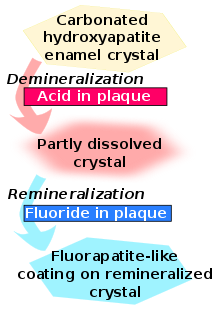
Remineralization is a natural process and does not have to involve fluoride.
Tooth remineralization is the natural repair process for non-cavitated tooth lesions,[1][2] in which calcium, phosphate and sometimes fluoride ions are deposited into crystal voids in demineralised enamel. Remineralization can contribute towards restoring strength and function within tooth structure.[3]
Demineralization is the removal of minerals (mainly calcium) from any of the hard tissues: enamel, dentine, and cementum.[4] It begins at the surface, and may progress into either cavitation (tooth decay) or erosion (tooth wear). Tooth decay demineralization is caused by acids from bacteria in the dental plaque biofilm whilst tooth wear is caused by acids from non-bacterial sources. These can be extrinsic in source, such as carbonated drinks, or intrinsic acids, usually from stomach acid coming into the mouth. Both types of demineralization will progress if the acid attacks continue unless arrested or reversed by remineralization.[5][6]
- ^ a b Featherstone, J. D. B. (2008). "Dental caries: A dynamic disease process". Australian Dental Journal. 53 (3): 286–291. doi:10.1111/j.1834-7819.2008.00064.x. PMID 18782377.
- ^ Fejerskov, O., Nyvad, Bente, & Kidd, Edwina A. M. (2015). Dental caries: The disease and its clinical management (Third ed.),
- ^ Cochrane NJ, Cai F, Huq NL, Burrow MF, Reynolds EC. New approaches to enhanced remineralization of tooth enamel. Journal of Dental Research. 2010 Nov 1;89(11):1187-97.
- ^ Li, Xiaoke; Wang, Jinfang; Joiner, Andrew; Chang, Jiang (2014). "The remineralization of enamel: a review of the literature". Journal of Dentistry. 42: S12–S20. doi:10.1016/s0300-5712(14)50003-6. PMID 24993850.
- ^ Garcia- Godoy, F. & Hicks, J. (2008). Maintaining the integrity of the enamel surface. American Dental Association, 139(3).
- ^ Hicks J, Garcia-Godoy F, Flaitz C. Biological factors in dental caries: role of saliva and dental plaque in the dynamic process of demineralization and remineralization (part 1). Journal of Clinical Pediatric Dentistry. 2004 Sep 1;28(1):47-52.
© MMXXIII Rich X Search. We shall prevail. All rights reserved. Rich X Search
